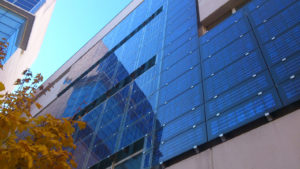 Imagine a future where a building’s energy comes from its windows. Many scientists have worked towards that future in the lab, but now five scientists from Los Alamos National Laboratory have demonstrated solar window technology can indeed be scaled up. Instead of palm-sized models, they created solar windows large enough to power entire buildings.
Imagine a future where a building’s energy comes from its windows. Many scientists have worked towards that future in the lab, but now five scientists from Los Alamos National Laboratory have demonstrated solar window technology can indeed be scaled up. Instead of palm-sized models, they created solar windows large enough to power entire buildings.
 “Luminescent concentrators (LSCs)” are a key component of the team’s solar windows,” according to a statement from the National Laboratory. LSCs can collect sunlight over large areas, and function as “light-management devices.” They collect sunshine via colloidal quantum dots, which have beneficial properties such as the ability to withstand light hitting them over and over. Colloidal quantum dots have a “high photostability,” which means sunlight won’t break them down.
“Luminescent concentrators (LSCs)” are a key component of the team’s solar windows,” according to a statement from the National Laboratory. LSCs can collect sunlight over large areas, and function as “light-management devices.” They collect sunshine via colloidal quantum dots, which have beneficial properties such as the ability to withstand light hitting them over and over. Colloidal quantum dots have a “high photostability,” which means sunlight won’t break them down.
The team used a “doctor-blade” technique to create the LSC windows. This technique is often used in printing to remove excess ink and leave behind a uniform film. The scientists drew on the printing technique to add a thin, uniform layer of a “dot/polymer composite” on large glass slabs that could be put into buildings. Lead scientist Victor Klimov said the solar windows could “turn presently passive building facades into power generation units.”
As detailed in their research published online by Nature Energy this week, the scientists hope the use of LSCs could reduce solar power costs. Their solar windows likely wouldn’t need as many “expensive photovoltaic materials” as other solar modules. They also noted solar windows would be incredibly beneficial for urban spaces, where there may not be as much room for solar panels.
Images via Los Alamos National Laboratory and Wikimedia Commons
Sourced from: Inhabitat.com

 Fluorophores in the LSCs also help the windows do their job. After light is collected, the chemical compounds re-emit photons. Photovoltaic cells can then collect the photons after they are guided towards the cells via “total internal reflection.”
Fluorophores in the LSCs also help the windows do their job. After light is collected, the chemical compounds re-emit photons. Photovoltaic cells can then collect the photons after they are guided towards the cells via “total internal reflection.”